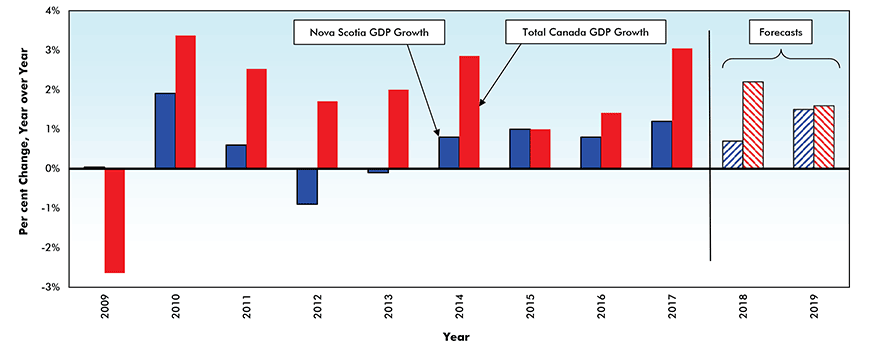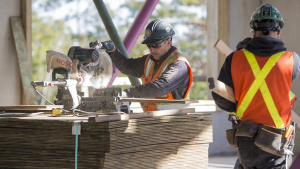After posting a gain of 1.2% in 2017, the currently available data suggests that Nova Scotia’s economy will likely expand in the range of 0.5% to 1% this year and quite possibly by 1% to 2% in 2019.
This near-term picture of softer growth is reinforced by the latest provincial job statistics which indicate the economy has lost some of the momentum it gained late in 2017.
Following a series of month-over-month gains through late 2017 and extending into the first quarter of this year, employers have become more hesitant about adding both full- and part-time staff. This slowdown in hiring is reflected in the province’s unemployment rate (currently 8%) which has trended steadily higher from the 30-year low of 6.7% it hit this April.
However, two indicators suggest that the province’s employment picture may be getting brighter. First, according to the Canadian Federation of Independent Business (CFIB) July Business Barometer, full-time staffing plans remain strong in the province. In line with the healthy staffing plans noted above, the CFIB’s Help Wanted report indicates that Nova Scotia’s job vacancy rate increased from 2.4% to 2.5% in the second quarter, its highest value since the first quarter of 2008.
Although the United States is by far Nova Scotia’s major trading partner, accounting for approximately 63% of the province’s exports over the past six months, the combination of a 46% ytd increase in sales of seafood and a 34% jump in wood pulp shipments to China have made the single largest contribution to the province’s 9.3% increase in total exports.
Although increased maritime regulation could temper this growth, the outlook for both of the province’s major foreign markets remains positive. This strength in merchandise trade is augmented by a boost in the province’s travel and tourism account due to a 53.7% ytd increase in trips of one or more nights by non-residents to the province.
Consistent with the above-noted slowdown in hiring and an associated softening in growth of average weekly wages, consumer spending, reflected by retail sales, has grown by 3.7% year to date compared to a 7.6% y/y rise during the first half of 2017. More than half of this slowing in spending is the result of a 10% drop in new car sales which more than offset strength in sales of home furnishings, building materials and a price-induced increase in sales by gasoline stations.
Fuelled by a steady inflow of international migrants and despite the drag on housing demand caused by the mortgage stress test introduced at the beginning of the year, home sales in Nova Scotia are up by 5.8% year to date.
So far this year Nova Scotia is the only province in the country to have exhibited a year-to-date gain in home sales, with the bulk of them (53%) concentrated in the Halifax-Dartmouth metro area which added 6,750 new residents over the course of 2017.
Despite this recent strength in home sales, housing starts ytd are up by a very modest 1.3% due entirely to a 16.8% increase in starts of apartments which more than offset declines in starts of singles (-11.7%), semi-detached (-5.4%) and row (-20%) dwellings.
Given the fact that residential building permits have contracted by 18% during the first six months of the year, we expect 3,600 housing starts this year and a slightly higher 3,900 in 2019.
Based on the Statistics Canada Capital and Repair Expenditure Survey, the more recent Atlantic Province Economic Council’s Major Project Inventory and the year-to-date value of non-residential building approvals, the value of non-residential construction spending in Nova Scotia will probably contract by 5% to 15% in 2018 following back-to-back gains of 14.9% and 2.7% during the previous two years.
Looking ahead, the outlook for private sector capital spending is overshadowed by the lingering impact of the federal government’s failure to actively support the Energy East Pipeline and the persisting uncertainty regarding the North American Free Trade Agreement.
Having said this, the recent announcement by Pieridae Ltd that it is on track to gain approval for the $10 billion Goldboro LNG project, to be located 150 kilometres northeast of Halifax, would give a significant boost to Nova Scotia’s investment prospects. According to ConstructConnect Insight, the project, with a planned start date of April 2019, would result in the construction of up to two liquefied natural gas plants with annual capacity of 10 million tons.
In addition to Goldboro, the Bear Head LNG project with an estimated cost of $4 billion has received all necessary project approvals from both the Nova Scotia and federal governments. However, plans to move forward on the project appear contingent on what happens to natural gas prices which have been moving sideways since the beginning of the year.
Real* Gross Domestic Product (GDP) Growth – Nova Scotia vs Canada

Chart: ConstructConnect – CanaData.











Recent Comments
comments for this post are closed